Did you know that over 200,000 Filipinos lost their lives during the struggle for independence against colonial powers? This staggering number reflects the deep-rooted desire for freedom that shaped the history of the Philippines.
For more than three centuries, Spanish colonial rule dominated the country, influencing its culture, economy, and politics. However, this period also sowed the seeds of a powerful movement—Filipino nationalism. This growing sense of unity and identity became the driving force behind the revolution that sought to reclaim self-governance.
The interplay between oppressive colonial policies and the increasing capacity of the people to demand change led to a transformative era. Figures like José Rizal and Andrés Bonifacio emerged as symbols of resistance, inspiring a nation to rise against foreign control. Their efforts laid the foundation for a modern government rooted in cultural pride and historical awareness.
Key Takeaways
- Filipino nationalism emerged as a response to centuries of Spanish colonial rule.
- The revolution was fueled by a desire for independence and self-governance.
- Key figures like Rizal and Bonifacio became symbols of resistance.
- Colonial policies shaped the cultural and political landscape of the Philippines.
- The struggle for freedom united the nation and inspired future generations.
Introduction to Filipino Nationalism
The roots of Filipino nationalism trace back to centuries of resistance against colonial dominance. This movement was shaped by a collective desire for identity and independence, which emerged during the Spanish colonial period. The oppressive policies of colonial rulers fueled a growing sense of unity among the people, laying the foundation for a transformative era.
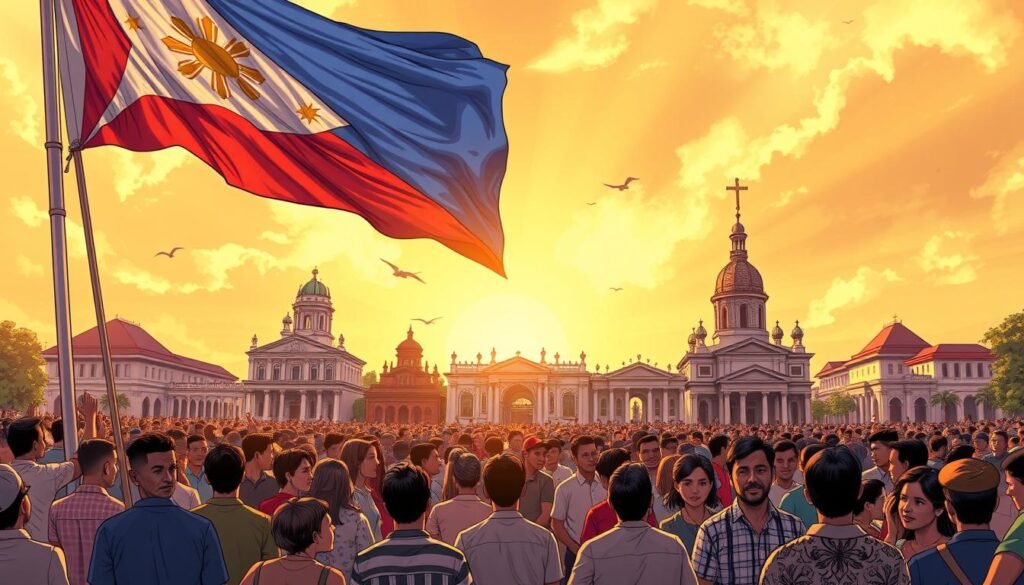
Enlightenment ideas played a significant role in inspiring early reformists and revolutionaries. These intellectual movements encouraged a shift in consciousness, empowering individuals to challenge foreign control. Figures like José Rizal and Andrés Bonifacio became symbols of this awakening, advocating for freedom and self-governance.
The connection between colonial partisanship and the eventual uprising for freedom is evident in historical events. For instance, the opening of Manila to world trade in 1834 exposed the Philippines to liberal ideas from Europe. This exposure, combined with economic shifts, further fueled the nationalist movement.
Filipino nationalism evolved from isolated acts of resistance to a unifying force that inspired the entire nation. It became a driving force behind the revolution, shaping the modern history of the Philippines. This movement not only sought independence but also aimed to reclaim cultural pride and historical awareness.
| Key Influences | Impact on Nationalism |
|---|---|
| Enlightenment Ideas | Inspired intellectual movements and reformist thinking. |
| Colonial Policies | Fueled resistance and unity among the people. |
| Economic Shifts | Exposed the Philippines to foreign ideologies and trade. |
| Historical Figures | Symbolized the struggle for freedom and self-governance. |
Historical Context of the Philippines
Before Spanish colonization, the Philippines was a land of diverse barangays and principalities. These small, independent communities were the foundation of early society. Each barangay was led by a datu, or chieftain, who governed with the support of elders and warriors.
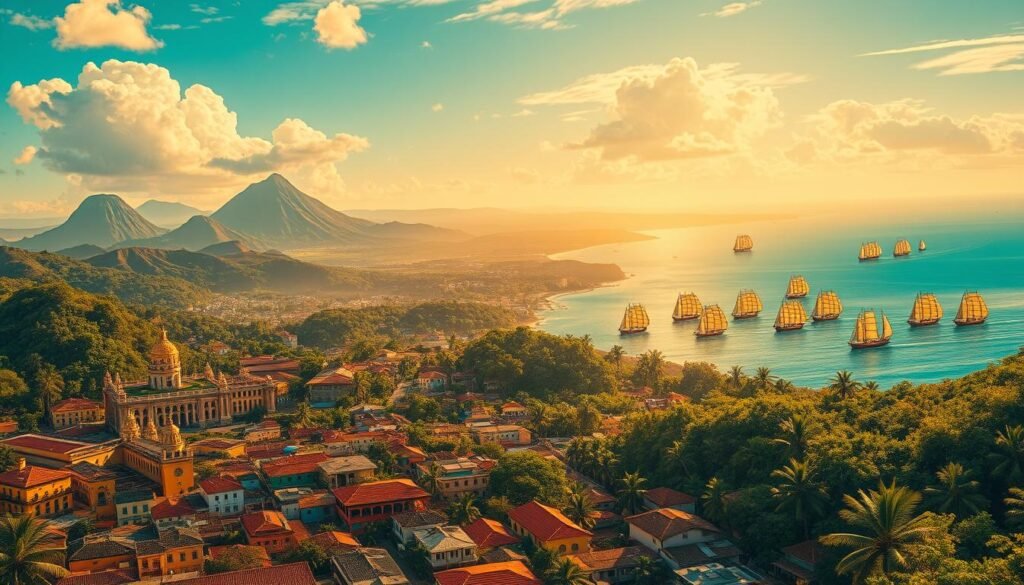
The arrival of Spanish explorers in the 16th century marked a turning point in the history of the archipelago. Miguel López de Legazpi, a key figure, established Spanish rule in 1565. His efforts led to the founding of Manila, which became the center of colonial administration.
Barangays and Early Principalities
Barangays were self-sufficient units with their own social and political systems. They thrived through trade, agriculture, and fishing. These communities were connected by alliances and conflicts, shaping the early state of the islands.
Spanish Colonization and Nation Formation
Spanish colonization unified the archipelago under a single political entity. The Spanish introduced new administrative systems, such as the encomienda, which transformed the relationship between the indigenous person and the state. This period laid the groundwork for the modern nation of the Philippines.
| Aspect | Impact |
|---|---|
| Pre-Colonial Barangays | Formed the foundation of early society. |
| Spanish Arrival | Marked the beginning of colonial rule. |
| Founding of Manila | Established the center of colonial administration. |
| Administrative Systems | Transformed governance and societal structures. |
The Birth of National Consciousness
The late 19th century marked a pivotal moment in the Philippines, as the educated elite began to challenge colonial dominance. This period saw the rise of the Ilustrados and Creoles, who played a crucial role in shaping a distinct national identity. Their efforts laid the groundwork for a unified movement toward independence.

Rise of the Ilustrados and Creoles
The Ilustrados, a class of educated elites, emerged as symbols of a new national identity. Exposed to Enlightenment ideas during their studies abroad, they brought back a heightened sense of consciousness and a desire for reform. Figures like José Rizal and Marcelo del Pilar became everyday heroes, inspiring others to question colonial rule.
Creoles, or locally born Spaniards, also played a significant role. Though they held privileged positions, many aligned with the Ilustrados in their quest for change. This alliance bridged class distinctions, uniting diverse groups under a common cause.
Intellectual movements further fueled this awakening. Publications like La Solidaridad became platforms for advocating reforms and fostering a sense of unity. These efforts not only challenged colonial policies but also redefined the nation’s identity.
| Key Figures | Contributions |
|---|---|
| José Rizal | Authored influential novels advocating reform. |
| Marcelo del Pilar | Edited La Solidaridad and promoted nationalist ideas. |
| Graciano López Jaena | Founded La Solidaridad and rallied support for reforms. |
| Andres Bonifacio | Founded the Katipunan, a revolutionary society. |
The birth of national consciousness was not just an intellectual movement but a call to action. It connected the struggles of the elite with the aspirations of the masses, paving the way for the eventual fight for independence.
Economic Transformations and National Identity
Trade and agriculture played pivotal roles in shaping the nation’s identity. The Philippines experienced significant economic shifts during the colonial era, which redefined its societal structure and influenced the movement toward independence.

Impact of the Galleon Trade
The Manila–Acapulco Galleon Trade connected the Philippines to the global economy for over two centuries. This trade route brought wealth and foreign goods, but its decline in the early 19th century marked a turning point. As the Galleon Trade faded, economic power shifted from colonial authorities to local entrepreneurs.
This change allowed the state to explore new economic opportunities. The decline also exposed the limitations of colonial policies, fostering a sense of self-reliance among the people.
Agrarian Shifts and Emerging Capitalism
Agrarian reforms in the 19th century transformed the Philippines’ agricultural landscape. The rise of private haciendas and the introduction of cash crops like sugar and tobacco created new wealth. These changes reshaped class dynamics, empowering local landowners and merchants.
Emerging capitalism further fueled economic growth. The government’s restructuring and trade liberalization policies encouraged local entrepreneurship. These shifts not only boosted the economy but also indirectly supported the growing desire for independence.
| Economic Shift | Impact on National Identity |
|---|---|
| Decline of the Galleon Trade | Shifted economic power to local entrepreneurs. |
| Agrarian Reforms | Empowered landowners and reshaped class dynamics. |
| Emerging Capitalism | Encouraged local entrepreneurship and economic growth. |
| Trade Liberalization | Fostered a sense of self-reliance and independence. |
Education and Enlightenment in the Philippines
Education became a powerful tool in shaping the Philippines’ journey toward independence. During the Spanish colonial era, royal orders expanded access to basic education, laying the groundwork for societal transformation. This shift not only improved literacy but also introduced Enlightenment ideas that sparked cultural and political change.
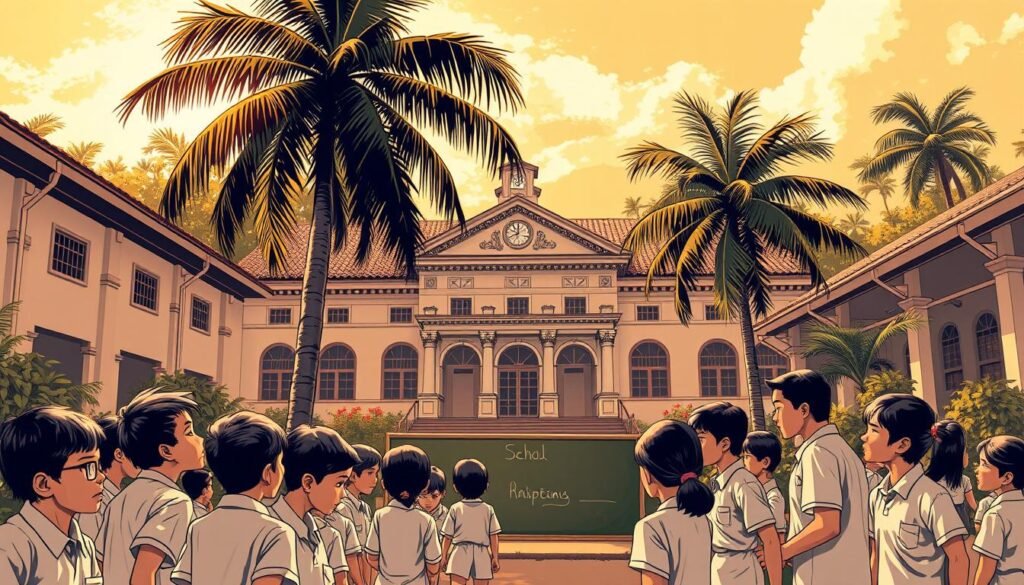
The expansion of schools during this period played a crucial role in fostering national awareness. Students and communities absorbed these new ideas, which challenged traditional colonial narratives. This intellectual awakening inspired a generation to question authority and envision a future rooted in self-governance.
Expanding Access to Learning
Royal orders mandated the establishment of public schools, making education more accessible to the masses. This policy shift empowered local communities, particularly the student population, to engage with progressive ideas. Schools became hubs of intellectual exchange, where discussions about freedom and identity flourished.
The role of education extended beyond the classroom. It transformed societal views on nationhood and governance, fostering a sense of unity among diverse groups. This shared experience of learning became a catalyst for broader social and political reforms.
| Key Educational Reforms | Impact on Society |
|---|---|
| Expansion of Public Schools | Increased literacy and access to Enlightenment ideas. |
| Role of Students | Became advocates for change and national awareness. |
| Community Engagement | Fostered unity and a shared vision for independence. |
| Cultural Transformation | Challenged colonial narratives and inspired reform. |
These educational reforms were instrumental in shaping the Philippines’ history. They connected the intellectual elite with the broader population, creating a unified movement toward independence. The spread of Enlightenment ideals through education laid the foundation for a modern, self-governing nation.
The Secularization of Philippine Parishes
The 18th century marked a significant shift in the religious and political landscape of the Philippines. A royal decree in 1774 initiated the secularization of parishes, transferring control from religious orders to native clergy. This move sparked a struggle against colonial church power and reshaped the nation’s history.
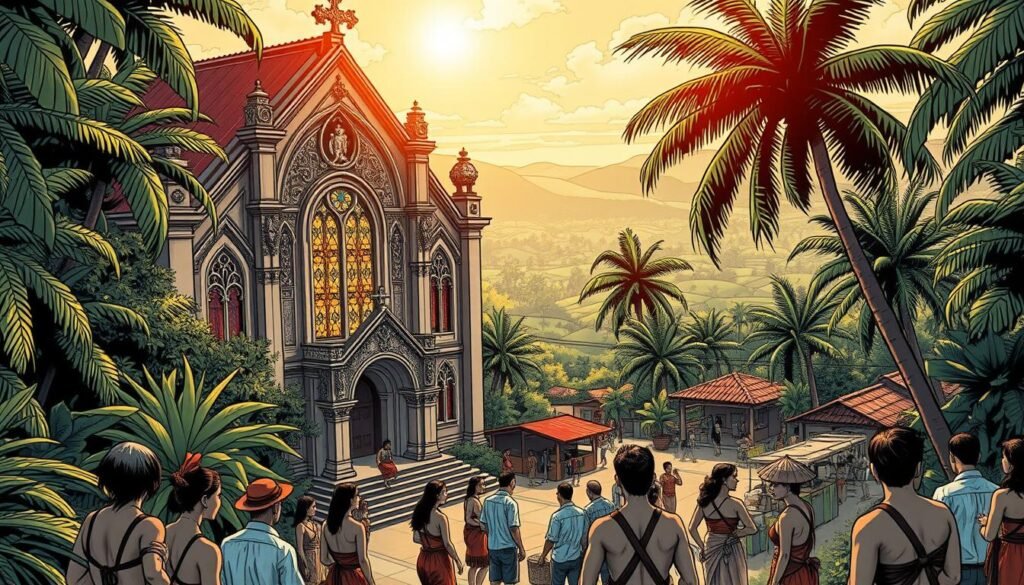
The expulsion of the Jesuits in 1767 accelerated this process. Native priests, often marginalized under colonial rule, were now entrusted with parish responsibilities. This change empowered local communities and challenged the dominance of foreign religious orders.
Jesuit Expulsion and Its Aftermath
The Jesuit expulsion was a turning point in the government’s approach to religious control. The colonial administration adopted a trial-like strategy to manage the transition, often clashing with church institutions. This period highlighted the tension between colonial authorities and the growing influence of native clergy.
The secularization effort also paralleled the broader fight for independence. As native priests took over parishes, they became symbols of resistance against colonial oppression. Their leadership inspired a sense of unity and self-determination among the masses.
| Key Events | Impact |
|---|---|
| Royal Decree of 1774 | Initiated the transfer of parishes to native clergy. |
| Jesuit Expulsion (1767) | Accelerated secularization and empowered local priests. |
| Colonial Government’s Trial Approach | Highlighted tensions between church and state. |
| Rise of Native Clergy | Inspired unity and resistance against colonial rule. |
The legacy of these reforms extended beyond religious control. They laid the foundation for future political and cultural developments, fostering a sense of national identity. The secularization of parishes remains a pivotal chapter in the Philippines’ journey toward independence.
Early Seeds of Revolution and Filipino Identity
The term “indio” once carried a derogatory meaning, but it evolved into a symbol of unity. Early reform movements and uprisings began to recast this label, transforming it into a badge of national pride. This shift marked the beginning of a collective identity that would drive the fight for independence.
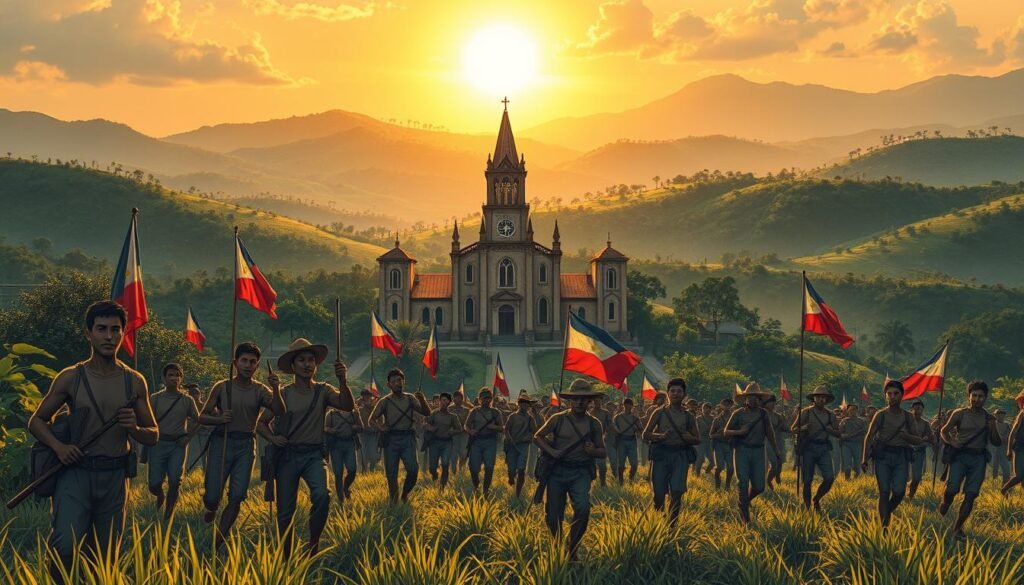
Revolutionary sentiments emerged among ordinary people, uniting them as one nation. The struggle against colonial rule brought together diverse groups, fostering a sense of shared purpose. This grassroots movement laid the foundation for a unified fight for freedom.
From Indios to a United People
Andrés Bonifacio played a pivotal role in this transformation. As a leader of the Katipunan, he inspired ordinary citizens to rise against oppression. His vision of a united people turned the once-derogatory term “indio” into a symbol of resistance and pride.
The concept of race and identity was redefined to include a diverse population. This inclusive approach strengthened the movement, as people from different backgrounds came together under a common cause. The revolution became a melting pot of cultures, united by a shared desire for freedom.
Early student involvement and grassroots leadership set the stage for a mass revolutionary movement. Young intellectuals and activists played a crucial role in spreading awareness and mobilizing communities. Their efforts ensured that the fight for independence was not limited to the elite but embraced by all.
This period marked a turning point in the nation’s history. The transformation from “indio” to a unified identity symbolized the birth of a new era. It was a testament to the power of collective action and the enduring spirit of the people.
The First Propaganda Movement and Reform
The late 19th century saw a surge of intellectual activism that reshaped the Philippines’ political landscape. Reform-minded individuals, including José Rizal, used journalism and public demonstrations to awaken a sense of national unity. This period marked the beginning of a cultural awakening that challenged colonial policies and inspired a movement for reform.
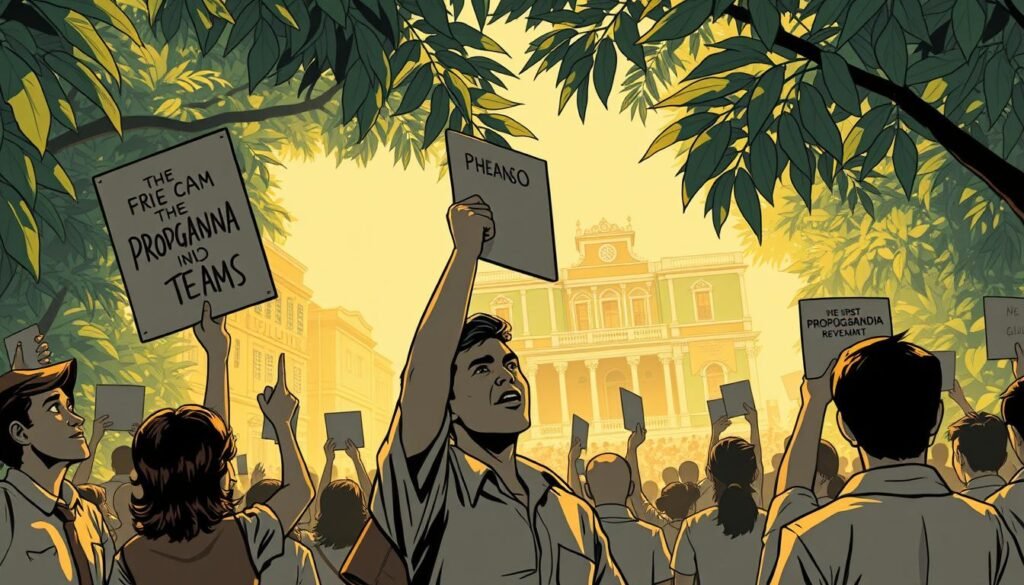
Cultural Awakening and Early Demonstrations
Newspapers and public orations became powerful tools for spreading ideas. Publications like La Solidaridad provided a platform for intellectuals to voice their demands for equality and representation. These efforts were not just about reform but also about reclaiming a shared history and identity.
Key demonstrations in Manila played a crucial role in mobilizing the masses. These events brought together people from different backgrounds, fostering a sense of unity. Public speeches and gatherings became spaces where ordinary citizens could express their grievances and aspirations.
Figures like Rizal emerged as heroes of this movement. Their writings and speeches inspired others to question colonial authority and envision a future rooted in self-governance. Rizal’s novels, Noli Me Tangere and El Filibusterismo, exposed the injustices of colonial rule and became rallying points for reform.
These early movements harnessed the power of peaceful advocacy. By challenging the government through intellectual and cultural means, they laid the groundwork for future revolutionary acts. The Propaganda Movement’s emphasis on education and awareness created a foundation for a unified fight for independence.
- Newspapers and public orations became tools for cultural awakening.
- Key demonstrations in Manila united diverse groups under a common cause.
- Figures like Rizal inspired a generation to demand reform.
- Peaceful advocacy challenged colonial policies and inspired future revolutionary acts.
For more detailed insights into this transformative period, explore the Propaganda Movement and its impact on the Philippines’ journey toward independence.
Second Propaganda Movement: Mobilizing Change
In the late 19th century, Filipino expatriates in Europe ignited a powerful movement for reform. This Second Propaganda Movement, active between 1872 and 1892, became a critical force in the fight for independence and equal rights. Using journalism and political debate, these intellectuals laid the groundwork for a unified national identity.
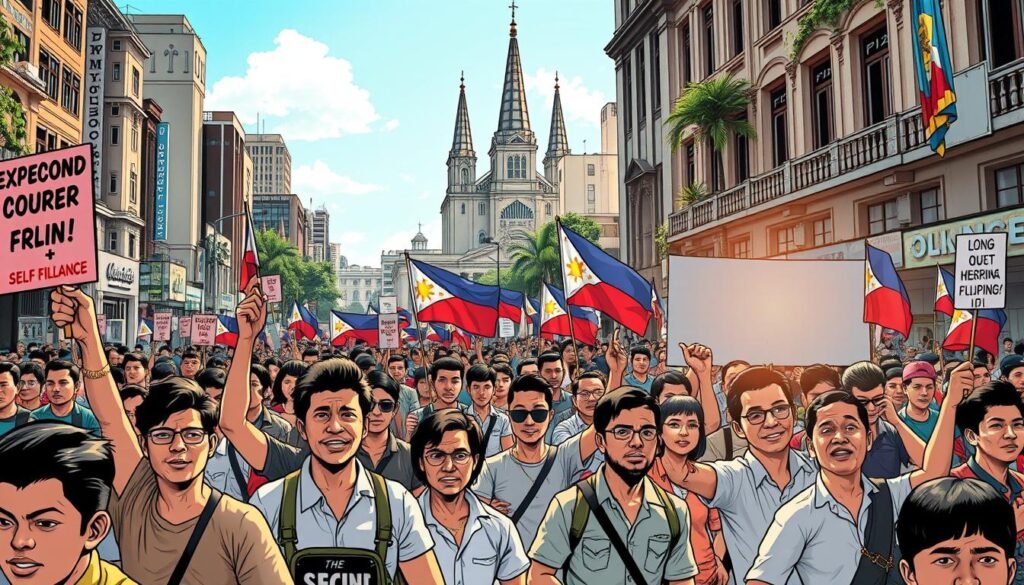
At the heart of this movement was La Solidaridad, a publication that served as a voice for reform. It provided a platform for expatriates to express their grievances and advocate for change. Through its pages, the movement challenged colonial policies and inspired a sense of unity among Filipinos abroad and at home.
Expatriate Intellectualism and La Solidaridad
The expatriate community in Europe played a pivotal role in shaping the nation’s future. Figures like Marcelo del Pilar and Graciano López Jaena used La Solidaridad to promote Enlightenment ideas and demand representation. Their writings not only exposed colonial injustices but also redefined the concept of history and identity.
This intellectual activism had a lasting impact. It connected the struggles of the elite with the aspirations of the masses, fostering a sense of shared purpose. The movement’s emphasis on education and awareness laid the foundation for future revolutionary acts, influencing leaders like Manuel L. Quezon.
- The Second Propaganda Movement united expatriates in the fight for reform.
- La Solidaridad became a powerful platform for advocating independence.
- Intellectuals redefined national identity and inspired future leaders.
- The movement’s legacy shaped the trajectory of the revolution.
For a deeper understanding of this transformative period, explore the historical insights provided by Fr. John Schumacher, SJ, a prominent historian of the Philippine Church and the Propaganda Movement.
Post-Propaganda Era and Revolutionary Ideals
The shift from peaceful reform to armed revolution marked a turning point in the fight for independence. After the decline of the propaganda movement, organized groups began to reject the status quo established by colonial government. This period saw the rise of revolutionary ideals that would reshape the nation’s future.
Heroes like Andrés Bonifacio emerged as symbols of resistance, inspiring ordinary people to join the cause. Their leadership transformed the struggle into a unified movement, challenging the colonial state and its oppressive policies. Everyday individuals played a crucial role, proving that the fight for freedom was not limited to the elite.
Revolutionary ideals took form through decisive acts of defiance. Events like the Grito de Balintawak in 1896 ignited widespread uprisings, uniting communities under a common goal. These moments of courage catalyzed future breakthroughs, paving the way for independence.
The colonial government faced increasing resistance as revolutionary groups reimagined the state. Their vision of a self-governing nation inspired a collective identity rooted in unity and pride. This period marked the birth of a new era, driven by the enduring spirit of the people.
- The transition from reform to revolution reshaped the political landscape.
- Heroes and everyday individuals played pivotal roles in advancing the cause.
- Decisive acts of defiance fueled the movement for independence.
- Revolutionary ideals challenged and redefined colonial governance.
For a deeper understanding of this transformative period, explore the Philippine Revolution and its impact on the nation’s journey toward freedom.
Modern Perspectives on Filipino Nationalism in Historical Context
Claro M. Recto’s vision for an independent Philippines continues to inspire modern debates on sovereignty and self-reliance. His ideas, rooted in the anti-colonial struggles of the past, remain relevant in today’s discussions on foreign policy and national identity. Recto’s call for an independent foreign policy and the removal of foreign bases resonates deeply with contemporary challenges.
Claro M. Recto’s Nationalist Vision
Recto, a former senator, was a staunch advocate for self-reliance and sovereignty. He believed that the Philippines should chart its own course, free from external influences. His speeches and writings emphasized the importance of building a self-reliant house of citizens, capable of standing firm against global pressures.
One of his most notable contributions was his push for an independent foreign policy. Recto argued that the government should prioritize the nation’s interests over alliances with superpowers like the United States. His vision was not just about political independence but also about fostering a sense of national pride and unity.
Foreign Policy and Contemporary Challenges
Today, Recto’s ideas are revisited in the context of modern foreign policy debates. The Philippines faces challenges from neighboring superpowers and the United States, making his call for independence even more pertinent. Intellectuals and returning student leaders continue to advocate for a self-reliant approach, inspired by Recto’s legacy.
The power dynamics in the region have shifted, but the core ideal of sovereignty remains unchanged. Recto’s vision serves as a reminder that the way forward lies in unity and self-determination. His emphasis on building a strong national identity continues to influence policy discussions and public discourse.
| Key Aspects | Impact on Modern Policy |
|---|---|
| Independent Foreign Policy | Encourages self-reliance and prioritizes national interests. |
| Removal of Foreign Bases | Strengthens sovereignty and reduces external influence. |
| National Pride | Fosters unity and a shared sense of identity. |
| Self-Reliance | Empowers citizens and builds a resilient nation. |
For a deeper understanding of how historical nationalism shapes modern perspectives, explore this insightful analysis on the rise of Filipino nationalism and its enduring impact.
The Importance of Historical Memory and Heritage
Historical memory shapes the identity of a nation, connecting past struggles to present aspirations. It serves as a bridge between generations, reminding us of the sacrifices made for freedom and unity. By preserving our heritage, we ensure that the lessons of the past continue to guide us.
Key dates and figures play a crucial role in reinforcing national pride. For example, the contributions of figures like Marco inspire us to uphold the values of courage and resilience. These stories remind us that the fight for independence was not just a moment in time but a continuous journey.
Heritage serves as a guiding light for future generations. It teaches us the importance of unity and the power of collective action. Events like the Grito de Balintawak are not just historical markers but symbols of a community’s determination to achieve freedom.
Collective memory keeps the spirit of independence alive. It ensures that the sacrifices of our ancestors are not forgotten. By remembering these stories, we honor their legacy and strengthen our resolve to protect our nation’s sovereignty.
| Key Elements | Impact on National Identity |
|---|---|
| Historical Memory | Connects past struggles to present aspirations. |
| Heritage Preservation | Guides future generations and fosters unity. |
| Key Dates | Reinforces national pride and collective consciousness. |
| Inspiring Figures | Encourage resilience and courage in the face of challenges. |
For more insights into preserving our cultural heritage, explore the initiatives by the National Historical Commission of the Philippines. Their efforts ensure that our history remains a source of inspiration for generations to come.
Future Trends: Nationalism in Today’s Philippines
In today’s rapidly changing world, the Philippines faces new challenges that shape its national identity. Globalization and regional pressures are redefining what it means to be a nation in the modern era. As the country navigates these complexities, the legacy of past struggles remains a guiding force.
Challenges and Global Influences
The Philippines must contend with powerful neighboring states and internal political dynamics. External influences, such as the United States and regional powers, continue to impact its foreign policy. These pressures challenge the country’s ability to maintain sovereignty and self-reliance.
Internal societal challenges also play a significant role. Rapid urbanization, economic inequality, and environmental issues test the resilience of the government and its people. These factors shape the way nationalism is expressed and understood in today’s context.
Past revolutionary ideals still resonate in modern political debates. Figures like José Rizal and Andrés Bonifacio inspire a sense of unity and pride. Their legacy reminds us that the fight for independence is an ongoing journey, not just a historical event.
- Globalization redefines national identity in the face of external pressures.
- Internal challenges like urbanization and inequality shape societal views.
- Revolutionary ideals continue to influence modern political discourse.
- External powers, including the United States, impact foreign policy decisions.
As the Philippines moves forward, nationalism will likely evolve to address these challenges. The power of collective action and shared identity will remain crucial in shaping the nation’s future. For more insights, explore the rise of nationalism in the 21st and its global implications.
Conclusion
Understanding the past is key to shaping a brighter future for any nation. The journey toward independence in the Philippines was marked by revolution and unity, driven by a collective desire for freedom. Historical milestones, from the Grito de Balintawak to the rise of key figures, continue to inspire national pride.
The government reforms and the sacrifices of past heroes remind us that the struggle for a better society is ongoing. Their legacy lives on in the heart of the people, guiding efforts to build a united and prosperous country. By remembering these lessons, we honor their sacrifices and strengthen our resolve.
For a deeper understanding of this transformative period, explore the historical analysis of Filipino nationalism and its enduring impact. The ideals of freedom and unity remain as relevant today as they were in the past.
FAQ
What sparked the rise of national consciousness in the Philippines?
The rise of national consciousness began with the Ilustrados, educated Filipinos who studied abroad and brought back ideas of reform and independence. Events like the secularization of parishes and the Galleon Trade also played key roles.
How did Spanish colonization shape the Philippines?
Spanish colonization introduced centralized governance, Christianity, and a class system. It also sparked resistance, leading to the eventual formation of a unified identity among the people.
What role did education play in the nationalist movement?
Education expanded access to Enlightenment ideas, empowering Filipinos to question colonial rule. Schools became hubs for intellectual discussions that fueled the push for reform and independence.
What was the significance of the Propaganda Movement?
The Propaganda Movement, led by figures like José Rizal, aimed to advocate for reforms through peaceful means. Publications like La Solidaridad spread nationalist ideas and united Filipinos in their struggle.
How did economic changes influence national identity?
The Galleon Trade and agrarian shifts created economic disparities, which fueled discontent. These changes highlighted the need for self-governance and strengthened the desire for independence.
What challenges does modern nationalism face in the Philippines?
Today, nationalism faces challenges like globalization, foreign policy pressures, and the need to balance tradition with modernization while preserving cultural heritage.
Why is historical memory important for Filipino nationalism?
Historical memory preserves the struggles and achievements of the past, inspiring future generations to uphold the values of independence, unity, and national pride.
Source Links
- Rizal planted seed of revolution; Bonifacio watered it
- Philippine National Independence, 1898–1904 (Chapter 12) – East Asia in the World
- Filipino nationalism
- History of the Philippine Revolution – National Commission for Culture and the Arts
- The Forming of a Filipino: On Nationalism, History, and Today
- Milestones in the History of U.S. Foreign Relations
- Propaganda Movement | Facts, Definition, & History | Britannica
- Shaping a Nation in Stone: Rizal and the Monuments of the Philippines’ American Colonial Era
- Colonial Contractions: The Making of the Modern Philippines, 1565–1946 – Oxford Research Encyclopedia of Asian History
- BTI 2024 Philippines Country Report
- Philippine Revolution | Facts, Leaders, & Significance | Britannica
- Philippine higher education and the origins of nationalism
- Secularization movement in the Philippines
- National Historical Commission of the Phillippines
- National Historical Commission of the Phillippines
- Scholarly Exploration of Nationalism: A Retrospective View
- Microsoft Word – Wang, You – Master’s thesis _one year_ in Global Studies
- Propaganda Movement
- National Historical Commission of the Phillippines
- The People Power Revolution, Philippines 1986
- Ilustrado, Revolutionaries or Accomplices of the Spanish Empire: The ContestedInfluence of Filipino Ilustrados on Philippine National Independence (1872-1898)
- Nationalism | Definition, History, Examples, Principles, & Facts | Britannica
- ‘I am safer in Hong Kong’: Transimperial entanglements in Filipino nationalist explorations | Modern Asian Studies | Cambridge Core
- Importance of Studying Philippine History | NAIS Manila
- The Future of Philippine Cultural Heritage: Strengthening Conservation Through Legislative Reform – AJA Law
- Revitalized Heritage: Restoring Historical Places in the Philippines
- Small States Navigate Great-Power Competition: Nationalism as Regime Survival
- July 4, 1946: The Philippines Gained Independence from the United States | The National WWII Museum | New Orleans
- New Zealand Journal of History
- Conclusion to Part III – Occupied

